 Yesterday at 1:35 I received a phone call from a second grade teacher, confirming that I was coming to her room at 1:50 to do a class lesson. I had three kids in my office and--because of the day I’d been having--no plan. Did I panic? Only on the inside. But it turned out to be my best lesson yet with this class, so I thought I’d share. For the past 5 weeks, I’ve been teaching these second graders about the Zones of Regulation. It was time to introduce the concept of the Size of the Problem. This particular room has more than its share of children who collapse on the floor rending their garments if someone else is chosen to be Line Leader. So here’s what I did: -Grabbed my trusty stack of index cards (if you stick with me you may want to buy some stock in index cards). On each of 18 cards I quickly jotted down a common kid-problem. This was easy, as all were--as they used to say at the beginning of L.A. Law--”ripped from the headlines” of daily life at PLS. I would have made more but, you know, time. I tried to achieve a rough balance between small problems, medium problems, and really big problems. Examples are below. -I took another 8 cards and wrote kids’ common reactions on each of those. Again, there was a range of sizes of reactions, from “Let it go” or “Say, ‘It’s no big deal’” to “Cry loudly” or “Hit someone.” For obvious reasons I did not include some of the less-common yet highly imaginative behaviors from my Counseling's Greatest Hits list, like "wet your pants whenever you hear the word 'no'" or "chase a classmate with a booger." -For the lesson, I read each problem card aloud and handed it to a student. If the student felt the problem was small, he’d stand by the cubbies. If it was medium, he’d move to the center of the room, and if it was large, he’d stand by the window. We all discussed whether we agreed with his choice, and had him change spots if indicated (here was where I realized the activity would work better with a smaller group, just because this took quite a bit of time, but it was still good). -After we finished that, all students with problem cards then moved to the rug with their cards, while I handed each of the remaining 8 a reaction card. I would choose one problem card child to stand and read his card to a reaction card child. The reaction card child would then act out whatever was written on her card. The kids LOVED this because sometimes it was so silly. Kid A: “You raised your hand, but the teacher called on someone else.” Kid B: (shrieks and kicks a chair) I made sure to create a couple of small problem/big reaction matches like the one above, as well as at least one big problem/small reaction combo (“Your uncle is in jail.” “It’s no big deal.”). Some of the others were appropriately matched. We'd decide whether each reaction was expected or unexpected when given the size of the problem. This turned out to be an effective way of demonstrating that 1) problems come in different sizes, 2) reactions also come in different sizes, 3) it’s pretty weird when the size of your reaction doesn’t match the size of the problem. In closing, I'd like to make a final, extremely important point. Please note that the size of my reaction (internal shrieking and swearing) totally matched the size of this problem, thus proving that I am not weird at all. Q.E.D. ***************************** Examples of problems (be careful that the big problems aren't a real-life issue for anyone in the group): You raised your hand but the teacher called on someone else; you’re stuck on a math problem; you just came back from Speech and you’re not sure what you should be doing; your uncle is in jail; your mom and dad are yelling at each other; your mom packed a kind of yogurt you don’t like; you didn’t get the red playing piece in the board game; no one will play with you; someone is sitting in the seat you wanted at lunch; your landlord is making you move out of your apartment; you have a substitute teacher; someone cut you in line; you fell and hurt your knee at recess; someone pushed you; your best friend is ignoring you (I could go on and on)... Examples of reactions: Let it go; break your pencil; ask for help; tell yourself, “It’s no big deal;” fix the problem yourself; throw yourself on the floor; cry loudly; use a calm-down strategy; tell how you feel; run out of the room, etc.
4 Comments
10 Reasons You Should Use Superheroes and the Unthinkables to Teach Social- Emotional Skills8/11/2014  Did you know that the Caped Crusader made his first appearance 75 years ago this summer? If he was 25 when he started fighting crime, that would make him older than I am! Holy colonoscopy, Batman! There are lots of superheroes who've been around long enough to collect Social Security. Yet there’s no denying---especially if you’ve turned on a television or spent more than five minutes on Pinterest---that their appeal is as strong as ever (which, sadly, is more than can be said of me). Using superheroes as a way to connect with clients in counseling is certainly not a new idea. I’ve done it off and on, here and there, since the early 90’s, and I’m sure lots of clinicians were using them long before that. But recently when I was creating a superhero-themed “social language” summer school program for ten elementary-aged students, I started to think more consciously about the reasons why superheroes are so effective as a counseling tool, especially with children. There are a lot.  1. Superheroes have POWER. Most of the time a superhero looks like a perfectly average person, but that appearance is deceiving. Even those whose alter egos are from traditionally disenfranchised groups like minorities, women, or dorky teens end up acquiring great power (see Cyborg, Wonder Woman, and Spider Man). Kids by definition have virtually no control over anything, so they identify with those characters and root for them in a big way. 2. Superheroes lead exciting lives. Flying through the air, leaping from rooftop to rooftop, crawling up the sides of skyscrapers, and driving really fast are all a heck of a lot more interesting than going to school, feeding the cat, and going to bed at 8:30. Trust me, I should know. 3. Superheroes overcome major life challenges. The backstories of many superheroes often include a tremendous loss, a traumatic history, or a serious character flaw. Bruce Banner has a teensy anger management issue. Bruce Wayne and Peter Parker's parent figures are murdered. Yet heroes don't allow adversity to define or limit them; in fact sometimes these challenges are what drive them to achieve greatness. 4. Superheroes can fight back. Sure, they have vulnerabilities---some significant---but they also always have at least one major strength that helps them fight or stand up to their enemies. Kids will buy in to the idea that they have a special power too, making it part of our job to help them figure out what it is and how to use it. 5. Superheroes often have a dual identity or a secret self, which can foster feelings of loneliness or of not fitting in. Dude, who doesn't? I think we can all relate. 6. Superheroes almost always win in the end. Even when things spiral out of control and our hero appears doomed, we don’t completely give up hope. We may clap our hands over our eyes for a moment, but some tiny piece of us remains confident that our hero will triumph. The whole exercise fosters resilience and optimism, two traits we wholeheartedly try to grow in our kids. 7. Superheroes can be a way of connecting with others. They've been around for so long and have such a broad appeal that people of all ages and backgrounds, or who have a fraught history with each other, can use them to find common ground. 8. Superheroes get to wear capes. ‘Nuff said. That was eight solid therapeutic reasons to go with a superhero theme for my social language program. But engaging the kids was only part of my goal. I also wanted a way to teach skills within the superhero framework. I turned to Michelle Garcia Winner’s Superflex: A Superhero Social Thinking Curriculum, a resource I used during the school year. Her Social Thinking theory involves working with students to help them try and understand others’ actions, intentions, and feelings so they can adjust their own behavior accordingly. What I like best about the Superflex curriculum is the cast of “Unthinkables:” dastardly foes who get into people’s brains and make them (for example) only think about their own plans, get stuck on their ideas, or have huge upset reactions. The Unthinkables were a perfect addition to my Superhero Training Academy. 9. The Unthinkables are easy for kids to accept and understand as part of the superhero narrative. Every superhero has his nemesis, and each nemesis has his own special method of causing trouble, just like the Unthinkables. In Superhero Training Academy, our daily “B.O.L.O. (Be On the Lookout) Briefings” on the Unthinkables were a crucial part of the day. My friends took the acquisition of this information very seriously. They wanted to know what to look for and what special powers or strategies would defeat each Unthinkable we met. 10. Unthinkables allow children to separate the "unexpected" behavior from their own sense of self. When we tell kids their behavior is "unacceptable" or they're "making a bad choice," they hear, "You're unacceptable" or "you're bad." But when the adult and the child are working together to recognize and defeat an Unthinkable, the child herself is part of the team, not the cause of the problem. This is a subtle difference, but don’t underestimate the power of the message, "You’re not a 'bad kid,' you’re one of the good guys. You're just temporarily under the influence of one of those sneaky Unthinkables. " If there's not an existing Unthinkable for a social-emotional issue you'd like to address, you can customize one. For example, to correlate with the Zones of Regulation concept of Size of the Problem, I created "Magnifying Man," an Unthinkable who makes even very small problems appear large. Dispelling feelings of powerlessness, hopelessness, and self-blame: those are the amazing therapeutic powers of superheroes and the Unthinkables.  Read more about the Summer Social Superhero Squad p.s. I've dedicated a whole page to giving you some ideas, activities, and printables. It's still a work-in-progress, so keep checking back for updates. Enjoy!
 Those of you who have been checking in on my Facebook page this summer know that I had an absolute blast teaching in the Extended Year Program. This was my first summer school experience in my new district, and---for the first time ever---I was given a whole class instead of acting as a specialist providing 30-minute lessons to a bunch of classes. This made me more than a little nervous. Last spring when I started at my new school, I was given the previous counselor's office. Since he didn't see groups (what the what?) or have any materials other than about a dozen versions of Uno, he had been fine in a very VERY small space. With no windows. While it was certainly cozy, and the custodian had painted it a lovely periwinkle blue the weekend before I started, it wasn't conducive to working with groups or, you know, breathing. Also, for an hour after my 4th grade boys' group left, it always smelled like feet. So my awesome new principal (without me even asking because I'm no diva, people) assigned me a big, beautiful room---with windows!---overlooking the playground for this year. I've spent a lot of the summer working on it. My Pinterest addiction has come in mighty handy, let me tell you. Also, I've been clicking around to a bunch of other school counselors' websites to see what ideas I can steal. I mean "borrow." Here are the results:  My door. I have the obligatory "Where Am I?" thingy (which is an excellent question on so many levels), a couple of cool quotes, and mini appointment request forms with a "mail" basket to leave them in. This should work out well since the kids have to walk past my door on their way out to recess. On the other hand, they also have to pass right by on their way in AFTER recess. Uh-oh. 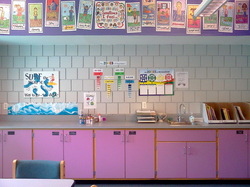 My "dealing with feelings" wall. It's mostly visuals re: anger management and Zones of Regulation. My daughter painted the "Surf the Angry Sea" canvas, which is a CBT idea. On top of the cabinets to the right of the sink I have boxes with my reference books sorted by topic (e.g., Service Learning, Self Expression, CBT). In the cabinets below are much bigger bins for the topics I use extensively. In those I have all my reference books, worksheets, and activity materials for Social Thinking, Zones of Regulation, Anger Management, Personal Space Camp, Bullies to Buddies, and Conflict Resolution. And yes, I'm so anal that I spray-painted office labels with chalkboard paint and stuck them on the doors. I admit I may have a problem.  "The Beach" I'm using the beach as a theme for helping kids learn multiple ways to calm down. There's the hula hoop-and-shower curtain hideaway, a table containing various calming activities (and under which there's a little rug, a yoga mat, and a basket of small stuffed animals for comfort). Not visible: a box of yoga cards with suggested poses, and "muscle-builders"---empty laundry detergent bottles weighted with sand. I also have made a play-list of calming music as well as one of upbeat songs for "Ms. Mendoza's Dance Party," which is one of the get-the-energy-out strategies. She's super freaky, yeow! 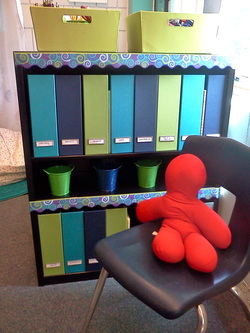 Book shelf. The Container Store really should give me a kick-back. Here are all my kids' books, also organized by topic. That's Mr. Squishy on the chair. He's WAAAAAAY more popular than I am! But he doesn't have his own website, so take that, Mr. Squishy!  My desk, which will never be clean again until June. I haven't decided yet how to decorate or use the space on the front of it, but I will. 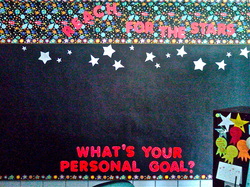 My bulletin board (being photo-bombed by a corner of the file cabinet). I'll update the photo when the board is complete (see update below). The first week or two I'm going to have kids trace their hands and arms onto big pieces of bright construction paper. They'll write a personal goal on the hand (I'm going to review my IEP goals with some of them as part of this process). Then on the arm they'll draw a ladder where they'll write the steps they'll need to follow to achieve their goal. It'll be a good way to monitor progress and keep us all on track. Love you, Pinterest! Mwuh!  Oh yeah, I HAVE STORAGE CABINETS! I'm using the outside space to put up some of my Social Thinking visuals, like the Thought Bubble vs. Speech Bubble and the Be a Social Detective graphics. I actually made up both of those on my own without Pinterest!. Huh. I'm just noticing how gross that chair is. We'll have to do something about that... 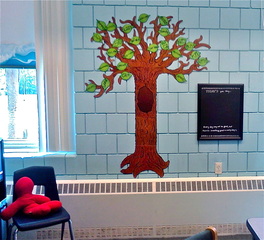 The "word wall" (or "word tree" if you want to get technical) and the blackboard I'm going to use---or have the kids use---to write positive things about the day. At the top it says "Today's good thing..." and at the bottom it says "Every day may not be good, but there's something good in every day." As part of my campaign to foster resilience, we're going to spend at least a little of every session accentuating the positive.  The back of my door is the "Worry Board" since I ran out of wall space for a Worry Wall. There's nothing on it yet, of course, since school hasn't started. This is another great way of visually tracking how kids are doing from week to week. Click on the above link for details. 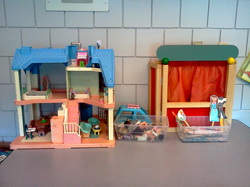 The imagination station. I'll use this stuff mostly for individual work. That dollhouse was the best $5 I ever spent (I got it at my church fair). In the plastic bin by the puppet theater are all the little puppets kids have made over the years out of card stock and popsicle sticks. Some of them are 20 years old! Hope you enjoyed the tour! 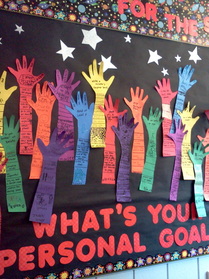 *** Update *** Here's my bulletin board after we did our personal goals. They ranged from "Get a pet" to "Earn a Chief's Award" (a big deal at my school) to "Stay off punishment at home." The kids did a terrific job. |
Author
|








 RSS Feed
RSS Feed